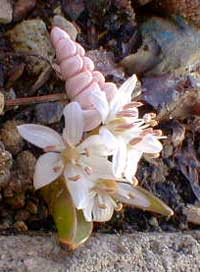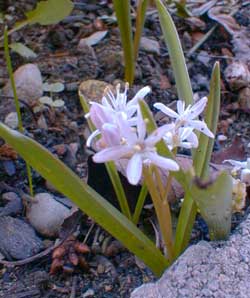
Rosy Twin-leaf Squill
"One of the most attractive things about flowers
is their beautiful reserve."
-Henry David Thoreau
(1817-1862)
(1817-1862)
Scilla bifolia rosea & S. bifolia carnea are synonymous. The species is so highly varied that some bulb vendors try to insinuate that the pinkest strains are 'Rosea' & the palest strains as 'Carnea.' But what they end up selling is usually the palest possible pink; I've yet to see an honestly deep pink.
 Rosy Scilla, an heirloom geophyte gardened since at least 1601, simply isn't very pink. It is off-white with, on close inspection, a faint blush of pink, most visible when the flower first emerges a muscari-like pyramid of buds. When planted alongside something completely white scilla, the whisper of a rosy glow is more evident.
Rosy Scilla, an heirloom geophyte gardened since at least 1601, simply isn't very pink. It is off-white with, on close inspection, a faint blush of pink, most visible when the flower first emerges a muscari-like pyramid of buds. When planted alongside something completely white scilla, the whisper of a rosy glow is more evident.It is one of the earliest of the early bloomers. Teency trusses of up to ten starry florets appear late-winter/early-spring, in March. The blooms tend to face upward into the sun rather than dangle like other scillas, so they make more of an impression than such a tiny plant would otherwise. In appearance its impact is more that of White Chionodoxa (glory-of-the-snow) than like other scillas, but in size it makes the diminuative Chionodoxa look enormous.
The stalk arises a mere two to five inches, from between a scant pair of leaves, hence the species name bifolia, two-leafed. Occasionally there will be a third smaller leaf, but these are never very grassy scillas.
Because they're so tiny, we placed twenty-five bulbs along the ledge of a raised garden that edges the patio, in front of a Tatting Fern (Athyrium filix-femina 'Frizelliae') expecting the fern to not yet have returned for spring when the tiny twin-leaf squills are flowering. But as the tiny flowers finish off, the fountaining reach of the tatting fern will keep the squill's strip of ground from seeming empty.
This plan pretty much worked as intended, but the little rosy scillas in full bloom at only two or three inches tall were even smaller than I had anticipated, & made very little impact at all. The new plan for them is to lift them & replant the bulbs at the foot of a containered tree-like evergreen shrub, at the rim of the container, where they will help give the impression of a miniature landscape or bonsai.
It is not as heat-hardy as English Squill (Hyacinthoides non-scripta) or Spanish Squill (Hyacinthoides hispanica), nor as cold-hardy as Siberian Squill (Scilla siberica), so prefers a protected spot, although in our Zone 8 it never suffers, & does well in sun or part shade.
It naturalizes with ease, self-seeding willfully, the seeds maturing into bulbs old enough to flower in three years. It grows true from the seed, always retaining the 'Rosea' glow.